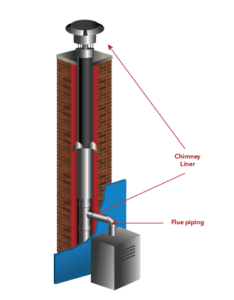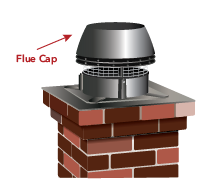Why Some HVAC Systems and Water Heaters Use Flue Pipes and Chimney Liners
HVAC systems that utilize a gas- or oil-fired furnace or boiler are equipped with flue pipes to vent harmful fuel combustion gases out of the property safely as they exit the heating equipment. Gas and oil water heaters are also connected to flue pipes. It’s critical for adjusters to understand how they work and when they can receive evaluation support for claims with these components.

Flue pipes begin at the connection to the boiler or furnace where the combustion gases exit the inducer motor housing. Gas and oil water heaters have a flue pipe connected at the top. The exhaust inside a flue pipe must remain warm while traveling to the exterior of the property so that the gas does not condense into a corrosive liquid and fall back into the system.
Some systems are located close enough to the roof or the wall they penetrate that they do not require chimneys to prevent condensation of the flue gases from occurring. However, flue pipes are often connected to heating equipment installed in the lowest areas of a house or building, such as a basement or crawlspace, but the exhaust is vented out of the top of the property, which can be several stories high. Similarly, some flue pipes are long enough that even indoor temperatures are cool enough to condense the flue gases if not insulated by a chimney.

Chimneys are typically built with chimney liners inside of them for added insulation from cold ambient air temperatures and winds that could otherwise cool the flue pipe and allow the gases to condense. Chimney liners also assist with airflow and ventilation of the rising gases. Flue pipes end where they connect to the chimney liner, which are usually constructed of varying forms of metal or clay and run the entire length of the brick-and-mortar chimney. Chimney liners terminate with a cap on top to prevent water from entering. When settling claims with these items, adjusters should make sure to get thorough evaluations for an accurate cause of loss and scope of damage.
HVACi is an all-in-one HVAC system and Refrigeration claims solution and desktop pricing option for insurance carriers. While HVACi does not inspect the brick-and-mortar structures of chimneys, the expert team does assess HVAC system items connected to them, including the entire flue pipe, chimney liner, and the cap on top. A masonry specialist must be consulted for chimney assessments and price verifications. HVACi also inspects gas and oil water heaters when they are part of the adjuster’s claim assignment. HVACi’s national network of technicians includes some who specialize in chimney liners and some who are equipped with appropriate scope tools that can enter and travel the length of the chimney to inspect the chimney liner. The HVACi team matches each claim with a knowledgeable, vetted technician in the loss location to ensure accurate, comprehensive, and timely assessments.
Contact HVACi or submit a claim to learn more about this specialized service and how HVACi can help adjusters more accurately settle these claims.

